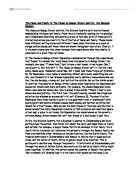The Home and Family in The House on Mango Street and Cry, the Beloved Country
The Home and Family in The House on Mango Street and Cry, the Beloved Country
The House on Mango Street and Cry, the Beloved Country both involve themes emphasizing the home and family. From the old Umfundisi seeking for his prodigal son to Esperanza searching and wanting a place of her own, both of these prolific stories involve how one reacts to the attraction of home and family. These novels have different writing styles and different ideas about the home as a place of refuge and belonging and these ideas are shown throughout each story. Over all, it is the main characters that show through their experiences why they desire to come back to a place they call home.
In The House on Mango Street, Esperanza communicates through her experiences that "home" is a dream that looks bleak from the poverty of Mango Street. For example, she says, "I knew then I had to have a real house. A real house. One I could point to. But this isn't it. The House on Mango Street isn't it. For the time being, Mama says. Temporary says Papa. But I know how those things go" (Cisneros, 5). For Esperanza, a real home is something distant and cloudy, something she can only look forward to in her dreams. Esperanza really desires a home where she can feel like she belongs, a home not just solid on the outside, but on the inside as well. In addition, the poverty on Mango Street causes more heartache for Esperanza and makes her dream even more sorrowful. For example, the shame Esperanza feels when a nun asks her where she lives is shown in her words: "There. I had to look where she was pointing - the third floor, the paint peeling, wooden bars Papa had nailed on the windows so we wouldn't fall out" (Cisneros, 5). The mortification Esperanza feels from having to point to the apartment over a "laundromat" with peeling paint and barred windows causes much shame and further solidifies her dream for a "real" house. Here we see the main theme of the novel and one that is woven around the story: Esperanza's desire to find a physical and emotional space of her own, a place to call home. For Esperanza, her experiences on the poverty - stricken Mango Street shame her, until her dream of a real house is just that.







